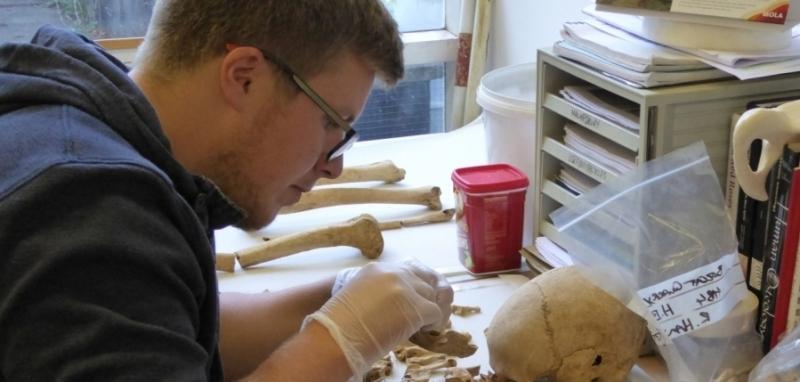Life and death at Field 44
Archaeological work continues on the proposed National Highways A428 Black Cat to Caxton Gibbet improvements. In this blog, we turn our attention to the human remains discovered at Field 44. The living and the dead were never far apart in this settlement and the evidence we found is helping to reveal more about ancient funerary practices.
How did they bury their dead in Iron Age England?
One of the big questions archaeologists are still working to answer, is how people buried the dead in Britain during the Iron Age (c. 800 BC-AD 43)? While we have plenty of evidence about people’s lives at the time, we have very little telling us about what happened after they passed away.
Archaeologists face two different problems. Firstly, the Iron Age human remains found aren’t enough to account for the substantial population of the British Isles at the time. This might mean most people had burial rites that left no traces – like being deposited in water. Secondly, human remains found suggest different communities followed very different traditions. From burial mounds to complete skeletons, or just a few individual bones. This makes it quite difficult to see the big picture.
Iron Age cemeteries are extremely rare and what archaeologists normally find are just individual bones recovered inside settlements. For a long time these isolated bones haven’t really been studied, because it was thought they could only provide limited information. However, things are now changing.
Research on Iron Age human bones has suggested certain complex burial rituals occurred at the time. By looking at how bones decay and signs of animal gnawing, cut marks, and fractures that occurred after death, we can reconstruct these practices. These studies have shown that firstly, the body was left exposed to the elements or buried in a shallow grave. It was then allowed to naturally decompose or be scavenged upon by animals until only the skeleton remained. Finally specific bones were recovered, often the skull or long bones, and kept by the community – sometimes for generations. It is possible, however, that such complex rites were reserved for selected members of the community.
How does the evidence from Field 44 fit in all this?
Isolated fragments of human skull were found in different parts of the site, including inside one of the roundhouses. Some of these bones have traces suggesting they may have been gnawed by scavenging animals or deliberately cut. As our osteologists (human bone experts) study them more closely over the coming months, we will be able to better understand how these marks came about.
By reading the signs left on these bones we will be able to reconstruct how human remains were treated by the people living at Field 44. The locations where they were found might also have a specific meaning or significance. We plan to look into it. The findings from Field 44 will then feed into wider research, helping archaeologists answer the big questions around burial rites in Iron Age Britain.

A Roman cemetery at Field 44?
The archaeologists digging at Field 44 also found two burials dating to the Roman period, just inside the northern boundary of the settlement. While their location inside the farmstead isn’t too strange, the position of these skeletons is quite unusual for this period. They are lying crouched on their sides, but the norm in Roman times was to bury the dead facing upwards.
We didn’t find any grave goods, so it is quite difficult to reconstruct who these individuals were and why they were buried like this. Their graves are also quite shallow, so it is entirely possible there used to be other graves nearby that were destroyed by modern ploughing – maybe there was a small cemetery at Field 44.
How do these discoveries fit into the bigger picture of Roman Britain?
Burial practices during the Roman period
Shortly before the Roman conquest in AD 43, cemeteries became more common and cremations increased, especially in south-east Britain. We believe this might have been influenced by contact with the Romans.
During the Roman period (AD 43-410) burial rites continued to evolve and change. From c. AD 100 burials gradually replaced cremations, slowly becoming the most common method of treating the dead throughout the Roman empire. Tombs were normally grouped in cemeteries, placed outside the limits of cities and towns. Cemeteries were rare in smaller rural centres and farmsteads. Here, burials are few and spread out. They are often found within the boundary of the settlement or just at its edge. This suggests only selected members of the community were buried, and the location of their graves might have been carefully chosen to send specific messages. It has been suggested these burials reinforced territorial boundaries or were symbolically connected with the farming cycle.
As our research and excavations in the surrounding area continues, we are keen to better understand the ancient burial practices of the region. Field 44 is proving to be a thought-provoking site to study, answering some questions while raising new ones. This small rural community has a lot to tell us about life – and death – thousands of years ago.
JOIN US ON OUR JOURNEY!
- @A428Cat
- Facebook.com/A428BlackCat
- #A428BlackCat
- Find out more about the A428 National Highways scheme
Excavations at Field 44 are being undertaken by archaeologists from MOLA and Cambridge Archaeological Unit, as part of the proposed National Highways A428 Black Cat to Caxton Gibbet Improvement Scheme managed by Skanska.